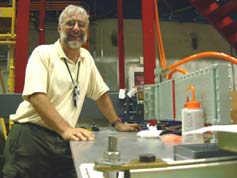
Handy Links
SLAC News Center
SLAC Today
- Subscribe
- Archives: Feb 2006-May 20, 2011
- Archives: May 23, 2011 and later
- Submit Feedback or Story Ideas
- About SLAC Today
SLAC News
Lab News
- Interactions
- Lightsources.org
- ILC NewsLine
- Int'l Science Grid This Week
- Fermilab Today
- Berkeley Lab News
- @brookhaven TODAY
- DOE Pulse
- CERN Courier
- DESY inForm
- US / LHC
SLAC Links
- Emergency
- Safety
- Policy Repository
- Site Entry Form

- Site Maps
- M & O Review
- Computing Status & Calendar
- SLAC Colloquium
- SLACspeak
- SLACspace
- SLAC Logo
- Café Menu
- Flea Market
- Web E-mail
- Marguerite Shuttle
- Discount Commuter Passes
-
Award Reporting Form
- SPIRES
- SciDoc
- Activity Groups
- Library
Stanford
Around the Bay
Experimental Work at SLAC Brings RF Design Effort to Life
 Rich Swent parts the thick plastic strips hanging from the doorframe and enters End Station B. He heads through the cavernous room, past spools of cables and under foot-thick cooling pipes, coming to a stop at a table. Currently cluttered with squirt bottles and tools, the aluminum surface will soon serve as the test stand for cutting-edge components made by SLAC for the International Linear Collider (ILC).
Rich Swent parts the thick plastic strips hanging from the doorframe and enters End Station B. He heads through the cavernous room, past spools of cables and under foot-thick cooling pipes, coming to a stop at a table. Currently cluttered with squirt bottles and tools, the aluminum surface will soon serve as the test stand for cutting-edge components made by SLAC for the International Linear Collider (ILC).
End Station B these days is the site of the largest ILC R&D effort at SLAC, the development of the L-band (1.3 GHz) radio frequency (RF) power source. This includes everything between the wall plug and the superconducting RF cavities: the modulators, klystrons, RF distribution, and fundamental mode couplers.
Chris Adolphsen is the scientific leader of this critical R&D effort. Chris has led the development of high power RF systems for the last decade, working first on the X-band normal conducting design and, more recently, on the L-band superconducting design. As a member of the GDE and one of the system leaders of the Main Linacs for the ILC Reference Design, he provides guidance for the world-wide linac design and R&D program. Chris' team at SLAC includes Mike Neubauer, Chris Nantista and Faya Wang and he works closely with Brian Rusnak from LLNL as well as collaborators from around the world.
Swent recently assumed responsibility for the implementation of the ILC L-band R&D activities in End Station B. He takes over from Marc Ross, who led the Operations Group at End Station B for many years and is now leaving SLAC to head the Technical Division at Fermilab. Swent joined SLAC last October after spending 18 years at Stanford working on the world's first superconducting linear accelerator and the free electron laser at Stanford's Hansen Experimental Physics Laboratory. Swent's direct team at SLAC includes Keith Jobe, Bobby McKee and John Wray.
"Rich is an exceptional experimental physicist with a long history of working on L-band RF linacs," says SLAC's ILC director Tor Raubenheimer. "He is a boon to our ILC effort."
While most physicists involved in the ILC concentrate on design, the team at SLAC is actually testing components. It's no small feat. "The scale of the ILC is mind-boggling. Components have to be very reliable or the machine would be down for maintenance all the time," says Swent.
He points to the newly assembled waveguide that ends on the test stand. It will funnel power from a 5 megawatt klystron. Over the drone of the ventilation fans, he explains, "We want to push the limits of what a superconducting cavity can do."
—Krista Zala
SLAC Today, September 20, 2006
Above image: Richard Swent